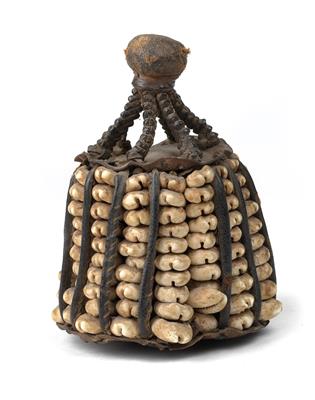Yoruba, Nigeria: A sacred object, called ‘ibori’.

The Yoruba believe that a man’s destiny, personality and success are already contained and pre-determined in his ‘inner head’. These sacred objects, called ‘ibori’, symbolise a man’s ‘inner head’. They are made of leather and are covered with vertical rows of cowrie shells on the outside. The inside contains sand, which has been previously ‘consecrated’ by the priest of the Ifa oracle (‘Babalawo’), as well as small objects associated with the owner’s ancestors, tutelary deities and taboos. The shape of an ‘Ibori’ always represents a highly abstract human being, with body, neck and a leather button on top, symbolising the head. These small ‘ibori’ are often enclosed and preserved in a larger leather container with a similar shape and likewise covered in cowrie shells, called ‘ile ori’ or ‘house of the head’. The present sacred object, ‘ibori’, is very old, displays a good patina as a result of protracted use and minor age damage (two external leather straps are torn, one is missing). Between the 19th and the early 20th centuries; H: 11 cm, DM: 8 cm (lower end). (ME)
Provenance: Austrian private collection.
Lit.: ‘Yoruba. Nine centuries of African Art and Thought’ by Drewal, Pemberton III and Abiodun, ill. 30, 32.
Esperto: Prof. Erwin Melchardt
 Prof. Erwin Melchardt
Prof. Erwin Melchardt
+43-1-515 60-465
erwin.melchardt@dorotheum.at
05.11.2014 - 13:00
- Prezzo realizzato: **
-
EUR 375,-
- Stima:
-
EUR 600,- a EUR 800,-
Yoruba, Nigeria: A sacred object, called ‘ibori’.
The Yoruba believe that a man’s destiny, personality and success are already contained and pre-determined in his ‘inner head’. These sacred objects, called ‘ibori’, symbolise a man’s ‘inner head’. They are made of leather and are covered with vertical rows of cowrie shells on the outside. The inside contains sand, which has been previously ‘consecrated’ by the priest of the Ifa oracle (‘Babalawo’), as well as small objects associated with the owner’s ancestors, tutelary deities and taboos. The shape of an ‘Ibori’ always represents a highly abstract human being, with body, neck and a leather button on top, symbolising the head. These small ‘ibori’ are often enclosed and preserved in a larger leather container with a similar shape and likewise covered in cowrie shells, called ‘ile ori’ or ‘house of the head’. The present sacred object, ‘ibori’, is very old, displays a good patina as a result of protracted use and minor age damage (two external leather straps are torn, one is missing). Between the 19th and the early 20th centuries; H: 11 cm, DM: 8 cm (lower end). (ME)
Provenance: Austrian private collection.
Lit.: ‘Yoruba. Nine centuries of African Art and Thought’ by Drewal, Pemberton III and Abiodun, ill. 30, 32.
Esperto: Prof. Erwin Melchardt
 Prof. Erwin Melchardt
Prof. Erwin Melchardt
+43-1-515 60-465
erwin.melchardt@dorotheum.at
|
Hotline dell'acquirente
lun-ven: 10.00 - 17.00
kundendienst@dorotheum.at +43 1 515 60 200 |
| Asta: | Tribal Art |
| Tipo d'asta: | Asta in sala |
| Data: | 05.11.2014 - 13:00 |
| Luogo dell'asta: | Wien | Palais Dorotheum |
| Esposizione: | 31.10. - 05.11.2014 |
** Prezzo d’acquisto comprensivo dei diritti d’asta acquirente e IVA
Non è più possibile effettuare un ordine di acquisto su Internet. L'asta è in preparazione o è già stata eseguita.
